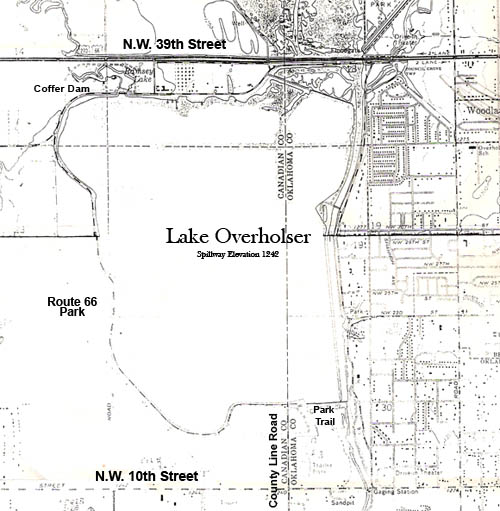LOCATION: Lake Overholser
Contributed by Jimmy Woodard
35.51375 N 97.67274 W (Coffer Dam)
35.49552 N 97.69185 W (Route 66 Park)
Lake Overholser is located in western Oklahoma County. It lies between Northwest 39th Street on the north and Northwest 10th on the south. The east boundary is Council Road and the west is roughly Sara Road. This man-made city reservoir is home to good birding almost year-round.
Points of Interest:
East dam, west dam, the park below the dam, West Overholser Drive, the new park at Northwest 23rd (west side), north shore pullouts, coffer dam/rollover dam, Lake Overholser Park and the “island.”
 With its variety of habitats, birding can be good here any season of the year. Obviously, spring and fall migrations are best with the combination of migrant passerines, shorebirds and waterfowl producing the largest numbers of birds. Winter can be productive with large rafts of ducks, gulls and cormorants, especially during iceover events.
With its variety of habitats, birding can be good here any season of the year. Obviously, spring and fall migrations are best with the combination of migrant passerines, shorebirds and waterfowl producing the largest numbers of birds. Winter can be productive with large rafts of ducks, gulls and cormorants, especially during iceover events.
Spring:
Rafts of ducks are common with Mallards, Shovelers, Green-winged Teal, Redhead, American Wigeon, Lesser Scaup, Bufflehead, and Ruddy Duck being the most numerous. Loons, grebes, gulls and terns are common. Watch for Common Loon, Horned and Eared Grebe, Franklin’s and Bonaparte’s Gulls, Forster’s and Black Terns. Passerines to look for are Yellow-billed Cuckoo, all swallows, Chimney Swift, Eastern Phoebe, Great-crested Flycatcher, Western and Eastern Kingbird, Scissortailed Flycatcher, House Wren, Ruby-crowned Kinglet, Swainson’s Thrush, Cedar Waxwing, Vireos, as well as Yellow-rumped, Nashville, Black & White and Parula Warblers. Added to this list are Indigo Buntings, Dickcissel, Baltimore Orioles, and American Goldfinch.
Summer:
Breeding birds are limited due to lack of extensive woods around the lake. The best areas are the park areas on the north and east sides of the lake and the woods below the dam. Look for Mississippi Kite, Yellow-billed Cuckoo, Common Nighthawk, Chimney Swift, Kingbirds, Scissortailed Flycatchers, Cliff and Barn Swallows, Carolina Chickadee, Tufted Titmouse, Carolina and Bewick’s Wrens, Eastern Bluebird, Robin, Mockingbird, Warbling Vireo, Common Yellowthroat, Indigo and Painted Buntings, Lark Sparrow, Baltimore Oriole, and American Goldfinch.
Fall:
Fall migration is less productive than spring but can hold a few surprises. Expect grebes, pelicans, egrets and herons, Snow Geese, ducks, Mississippi Kite, Osprey, Swainson’s Hawk, Sharp-shinned and Cooper’s Hawks, White-faced Ibis, gulls, terns, swallows, flycatchers, White-breasted Nuthatch, Blue-gray Gnatcatcher, vireos, warblers, Summer Tanager, sparrows, orioles and blackbirds.
Unusual birds would be bitterns, night herons, Broad-winged Hawk, rails, shorebirds, owls, Ruby-throated Hummingbird, Easter Wood Pewee, Marsh Wren, American Pipit, Rose-breasted and Blue Grosbeak, Clay-colored Sparrow, Yellow-headed Blackbird, and Pine Siskin.
Winter:
Large rafts of ducks become common, especially Common and Red-breasted Mergansers, Shovelers, Redheads, Lesser Scaup, Bufflehead and Ruddy Duck. Lesser numbers of teal, Gadwall, Canvasback, Ring-necked, Goldeneye, and Hooded Merganser may be present, Ring-billed, Herring and Bonaparte’s Gulls are regular. Cormorants and coots are common. Sparrows to watch for are Tree, Field, Song, Lincoln’s, White-throated, and Harris’s as well as Juncos.
Birds to be expected year-round are Pied-billed Grebe, Great Blue Heron, Canada Goose, Mallard, Red-tailed Hawk, Kestrel, Coot, Killdeer, Least Sandpiper, Ring-billed Gull, Rock Pigeon, Mourning Dove, Kingfisher, the Red-bellied, Downy and Flickers, Blue Jay, American Crow, Chickadee, Titmouse, Carolina and Bewick’s Wrens, Eastern Bluebird, Robin, Mockingbird, Starling, Cardinal, Red-winged Blackbird, Eastern Meadowlark, Great-tailed Grackle, Brown-headed Cowbird, House Finch, American Goldfinch, and House Sparrow.
The best vantage points for waterbirds on or over the lake depends on the time of day. In the morning, the best viewing is from the dam, the island, the north shore or the coffer dam. In the afternoon, viewing is better from the west side road, the new park at Northwest 23rd or the west end of the dam.
For passerines and other landbirds, the best locations are the woods below the dam, the coffer dam, the north shore pullouts and the park-like areas on the east side of the lake. Shorebirding is usually not great unless the lake level is down. When the fields west of the lake have standing water, shorebirds can be abundant near the new park at and along Northwest 23rd.
(Download printable map)

